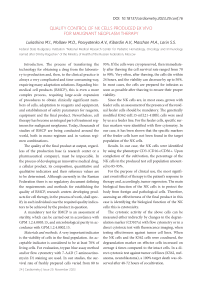Quality control of NK cells produced ex vivo for malignant neoplasm therapy
Автор: Lukashina M.I., Mollaev M.D., Posvyatenko A.V., Kibardin A.V., Maschan M.A., Larin S.S.
Журнал: Cardiometry @cardiometry
Рубрика: Conference proceedings
Статья в выпуске: 29, 2023 года.
Бесплатный доступ
The process of transferring the technology for obtaining a drug from the laboratory to production and, then, to the clinical practice is always a very complicated and time-consuming way, requiring many adaptation solutions. Regarding biomedical cell products (BMCP), this is even a more complex process, requiring large-scale expansion of procedures to obtain clinically significant numbers of cells, adaptation to reagents and equipment, and establishment of safety parameters for reagents, equipment and the final product. Nevertheless
Nk cells, bmcp, quality control, cytotoxity test
Короткий адрес: https://sciup.org/148327388
IDR: 148327388 | DOI: 10.18137/cardiometry.2023.29.conf.16
Текст статьи Quality control of NK cells produced ex vivo for malignant neoplasm therapy
Federal State Budgetary Institution “National Medical Research Center for Pediatric Hematology, Oncology and Immunology named after Dmitry Rogachev” of the Ministry of Health of the Russian Federation, Moscow
Introduction . The process of transferring the technology for obtaining a drug from the laboratory to production and, then, to the clinical practice is always a very complicated and time-consuming way, requiring many adaptation solutions. Regarding biomedical cell products (BMCP), this is even a more complex process, requiring large-scale expansion of procedures to obtain clinically significant numbers of cells, adaptation to reagents and equipment, and establishment of safety parameters for reagents, equipment and the final product. Nevertheless, cell therapy has become an integral part of treatment regimens for malignant neoplasms. Today, thousands of studies of BMCP are being conducted around the world, both in mono-regimen and in various regimen combinations.
The quality of the final product at output, regardless of the production base (a research center or a pharmaceutical company), must be impeccable. In the process of developing an innovative medical drug, a cellular product, its composition, quantitative and qualitative indicators and their reference values are to be determined. Although currently in the Russian Federation there is no regulatory document defining the requirements and methods for establishing the quality of BMCP, research centers developing products for cell therapy, in the process of work, shall specify in each individual case the required quality indicators to be achieved by the product in question.
A mandatory test for BMCP is an assessment of sterility, which can be carried out in accordance with GPM 1.2.4.0003.15, and microbiological purity in accordance with GPM.1.2.4.0002.15.
Materials and methods . A very important indicator is the viability of cells in the final population. An acceptable indicator is considered to be at least 70% of living cells. For evaluation, trypan blue assay method and/or flow cytometry with 7-AAD (7-aminoactino-mycin D) staining are used. In our studies, the survival rate of freshly prepared cells varied from 80 to 24 | Cardiometry | Issue 29. November 2023
95%. If the cells were cryopreserved, then immediately after thawing the cell survival rate ranged from 70 to 90%. Very often, after thawing, the cells die within 24 hours, and the viability can decrease by up to 50%. In most cases, the cells are prepared for infusion as soon as possible after thawing to ensure their proper viability.
Since the NK cells are, in most cases, grown with feeder cells, an assessment of the presence of the residual feeder cells should be mandatory. The genetically modified K562-mIL15-mIL21-41BBL cells were used by us as a feeder line. For the feeder cells, specific surface markers were identified with flow cytometry. In our case, it has been shown that the specific markers of the feeder cells have not been found in the target population of the NK cells.
Results . In our case, the NK cells were identified by using the phenotype CD3-/CD16+/CD56+. Upon completion of the cultivation, the percentage of the NK cells in the produced test cell population amounted to 85-95%.


